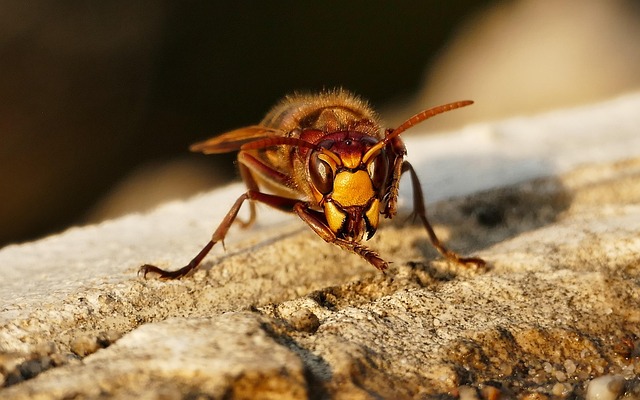Hornets require tailored, eco-conscious prevention strategies focusing on their preference for sheltered, high locations and sweet sustenance. Early detection using modern equipment like cameras and thermal imaging identifies nesting sites without harm. Strategies include regular tree trimming, sealing entry points, managing plant life, limiting sweet substances, and using natural repellents. Seasonal monitoring and year-round planning, including routine inspections and maintaining clutter-free spaces, ensure a hornet-free environment through minimal chemical interventions.
“Maintaining a hornet-free environment requires a multi-faceted approach, especially with the growing interest in eco-friendly solutions. This article explores comprehensive strategies to ensure your space remains safe and uninvited for hornets. From understanding their behavior and habitat to adopting sophisticated, environmentally conscious detection methods, we provide insights into prevention.
We delve into effective maintenance checks and regular inspections, offering a practical guide to year-round protection against these insects. Discover how these steps contribute to creating a peaceful outdoor haven with minimal environmental impact.”
Understanding Hornet Behavior and Habitat
Hornets, part of the wasp family, are social insects with distinct behaviors and habitat preferences. Understanding their habits is key to implementing effective eco-friendly hornet prevention strategies. These insects build intricate nests, often high up in trees or under eaves, seeking sheltered locations with easy access to food sources. They are attracted to sweet substances, which serve as a primary food source for their colonies.
Knowledge of hornet behavior allows for targeted maintenance plans. Eco-friendly prevention involves eliminating potential nesting sites by trimming trees and removing structures that provide hiding places. Regular inspections should be conducted to identify and seal entry points into buildings. Additionally, managing nearby plant life and limiting access to sweet substances can significantly deter hornets from establishing territories, promoting a hornet-free environment.
Eco-Friendly Detection Methods: Identifying Hornet Nests Early
Early detection is key in implementing effective eco-friendly hornet prevention strategies. While traditional methods often rely on visual inspections, these can be disruptive and may not always catch nests before they become established. Eco-conscious approaches focus on natural behaviors and signs to pinpoint hornet habitats discreetly. Trained professionals use specialized equipment like high-resolution cameras and thermal imaging to detect even the smallest nest openings or activity without causing distress to the environment.
By observing patterns in plant damage, pest activity, and bird behavior, experts can anticipate potential nesting sites. This proactive approach allows for targeted intervention using minimal chemical interventions. Regular monitoring during specific seasons helps maintain a hornet-free environment, ensuring the safety of both humans and local ecosystems without resorting to harmful pesticides.
Implementing Effective Prevention Strategies: A Comprehensive Approach
Implementing effective hornet prevention strategies is key to maintaining a hornet-free environment, especially for those who prioritize eco-friendly solutions. A comprehensive approach involves combining multiple methods to disrupt hornet habitats and reduce their attraction to certain areas. This includes regular cleanups to remove potential nesting sites, such as old wood or debris, and using natural repellents like citronella or lavender essential oils around the property perimeter.
Additionally, understanding hornet behavior is crucial. These insects are drawn to sweet scents and protein-rich sources. By limiting access to food sources and securing outdoor trash cans with tight lids, you can significantly deter hornets from settling in your area. A balanced combination of these eco-friendly hornet prevention tactics creates a harmonious coexistence, ensuring both human safety and the well-being of natural ecosystems.
Regular Maintenance Checks: Ensuring a Hornet-Free Environment Year-Round
Regular maintenance checks are a vital component of any eco-friendly hornet prevention strategy. By scheduling routine inspections, property owners and managers can identify potential hornet nests early on, before they become established. This proactive approach involves visually inspecting areas prone to hornet activity, such as attics, eaves, and trees, for any signs of nesting or unusual behavior. During these checks, professionals should also clean and seal entry points to prevent future invasions.
Implementing a year-round maintenance plan further reinforces the effectiveness of eco-friendly hornet prevention methods. Regular trimming of trees and shrubs keeps vegetation neatly pruned, reducing hiding spots for hornets. Additionally, maintaining a clean and clutter-free outdoor space minimizes potential nesting sites. By combining these practices with other natural deterrents, such as specific plant scents or decoy nests, individuals can create an environment that discourages hornets while promoting ecological balance.
By understanding hornet behavior, employing eco-friendly detection methods, and implementing robust prevention strategies, regular maintenance checks can ensure a hornet-free environment throughout the year. These comprehensive approaches not only protect homes and businesses but also promote a harmonious coexistence with these fascinating creatures, highlighting the balance between human safety and ecological preservation in the context of eco-friendly hornet prevention.
